FER-DE-LANCE
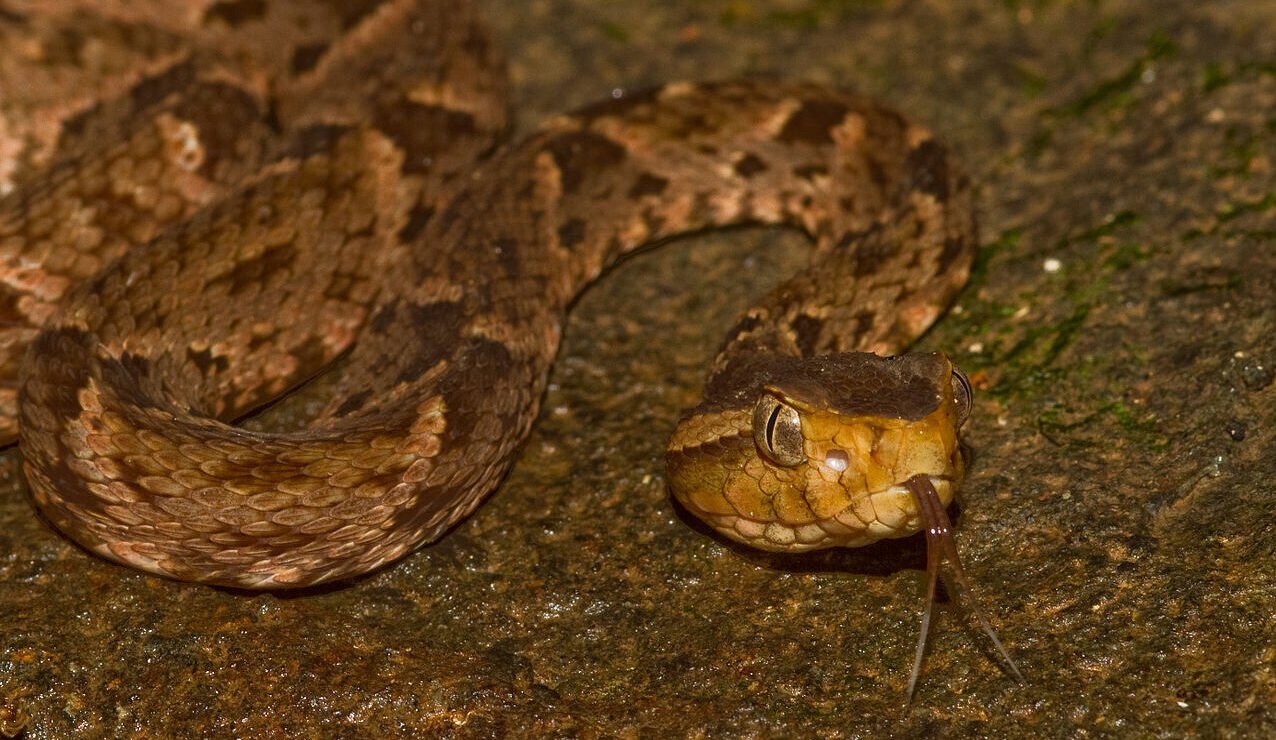
This is one animal that you can happily avoid seeing in Costa Rica! When locals and expats hear the name Fer-de-Lance, their attention is roused. Many of us have come across this snake in the jungles. Some have seen it slithering across the road, others found it coiled up in their backyards. A few had very narrow escapes. The stories are exchanged over beers and get more impressive with each telling. But one thing’s for sure – Costa Rica would not be the same without the legendary, bigger-than-life serpent!


⚠️🐍 A REPUTATION NOT EXAGGERATED
In Costa Rica’s tangled rainforests, misty lowlands and urban townscapes few creatures command more caution than the Fer-de-Lance (Bothrops asper). Known locally as Terciopelo and Barba Amarilla in Latin countries outside Costa Rica, this venomous pit viper is both feared and revered. The snake is dubbed “The Ultimate Pit Viper” for its defensiveness, large size, fangs and potent venom yield. It has a fearsome reputation. But nonetheless, like all venomous snakes, the Terciopelo actively avoids contact with humans and larger animals, with bites generally only occurring when the snake is cornered, pursued, or threatened.
Terciopelo means “velvet” in Spanish—a reference to its smooth, dark scales. Fer-de-Lance, French for “spearhead,” describes its triangular head and swift strike. These are the most common terms in Costa Rica.
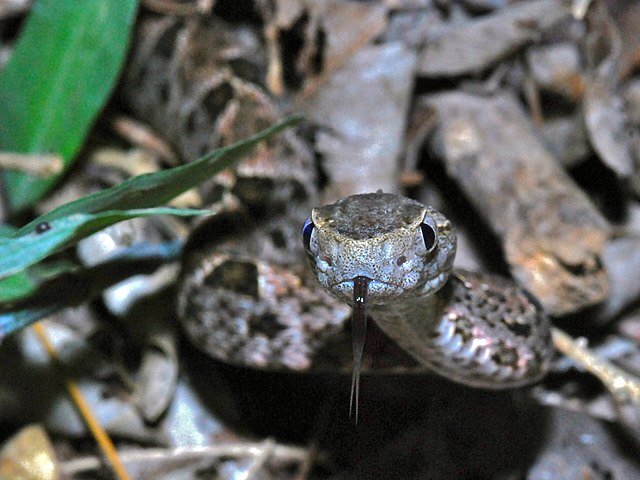
But it’s not just the most dangerous snake in the country—responsible for majority of venomous bites and deaths. It’s also a keystone predator, regulating rodent populations and shaping the forest floor’s delicate balance. And its venom is being used to develop various medical advancements.
⚡🐍 A LIGHTNING FAST BITE
The Fer-de-Lance strikes with startling speed and precision, often without warning. When threatened or startled—especially by sudden movement or close proximity—the snake becomes very dangerous. It coils and launches forward in a rapid, whip-like motion. Its long, hinged fangs penetrate deeply. They deliver a potent dose of hemotoxic venom that begins breaking down tissue and disrupting blood flow almost immediately. Unlike some snakes that bite and retreat, the Fer-de-Lance may hold its grip momentarily before recoiling. Its camouflage makes it nearly invisible on the forest floor, so many bites occur when people unknowingly step too close. The snake’s defensive response is not out of aggression, but survival instinct.
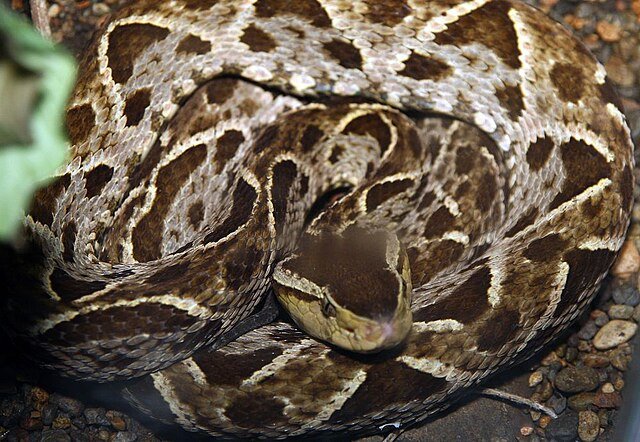
⚠️☠️ VENOM
The Fer-de-Lance is responsible for about half of the 700 annual venomous snakebites in Costa Rica. Its venom is hemotoxic, meaning it:
- Destroys tissue
- Disrupts blood clotting
- Causes internal bleeding
- May lead to necrosis or organ failure
Symptoms include intense pain, swelling, blistering, and in severe cases, amputation or death. However, Costa Rica’s Instituto Clodomiro Picado produces effective antivenoms, and fatalities remain below 1.5% thanks to rapid medical response.
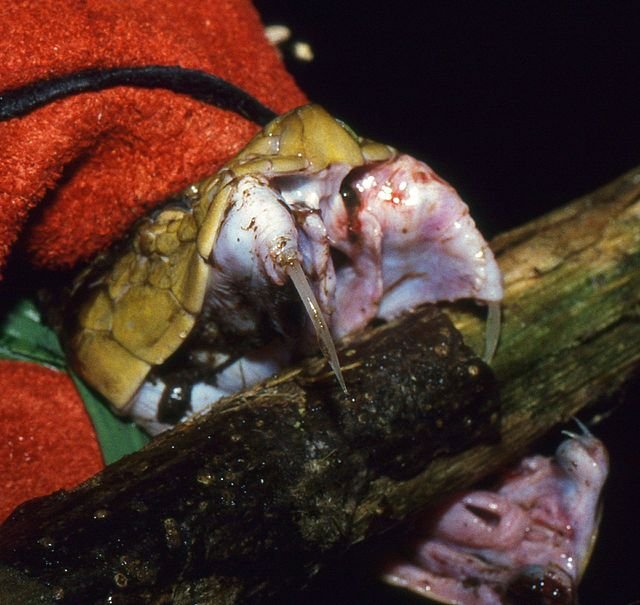
🥾🌳 HOW & WHEN DO PEOPLE GET BITTEN
Most Terciopelo bites in Costa Rica occur when people accidentally get too close—often without realizing the snake is there. Its camouflage is so effective that it blends seamlessly into leaf litter, forest trails, and plantation undergrowth. The majority of bites happen in rural agricultural areas, especially banana and cacao plantations. Workers unknowingly step near or disturb the snake while harvesting or clearing brush.

Hikers and tourists are also at risk, particularly when walking off marked trails or during low-light conditions. It is then that the Fer-de-Lance is most active. Because it’s a nocturnal ambush predator, it tends to lie motionless and strike only when startled. This makes accidental encounters the most common cause of bites. Locals even refer to it as the “Costa Rican landmine”, a nickname that reflects both its stealth and sudden danger.
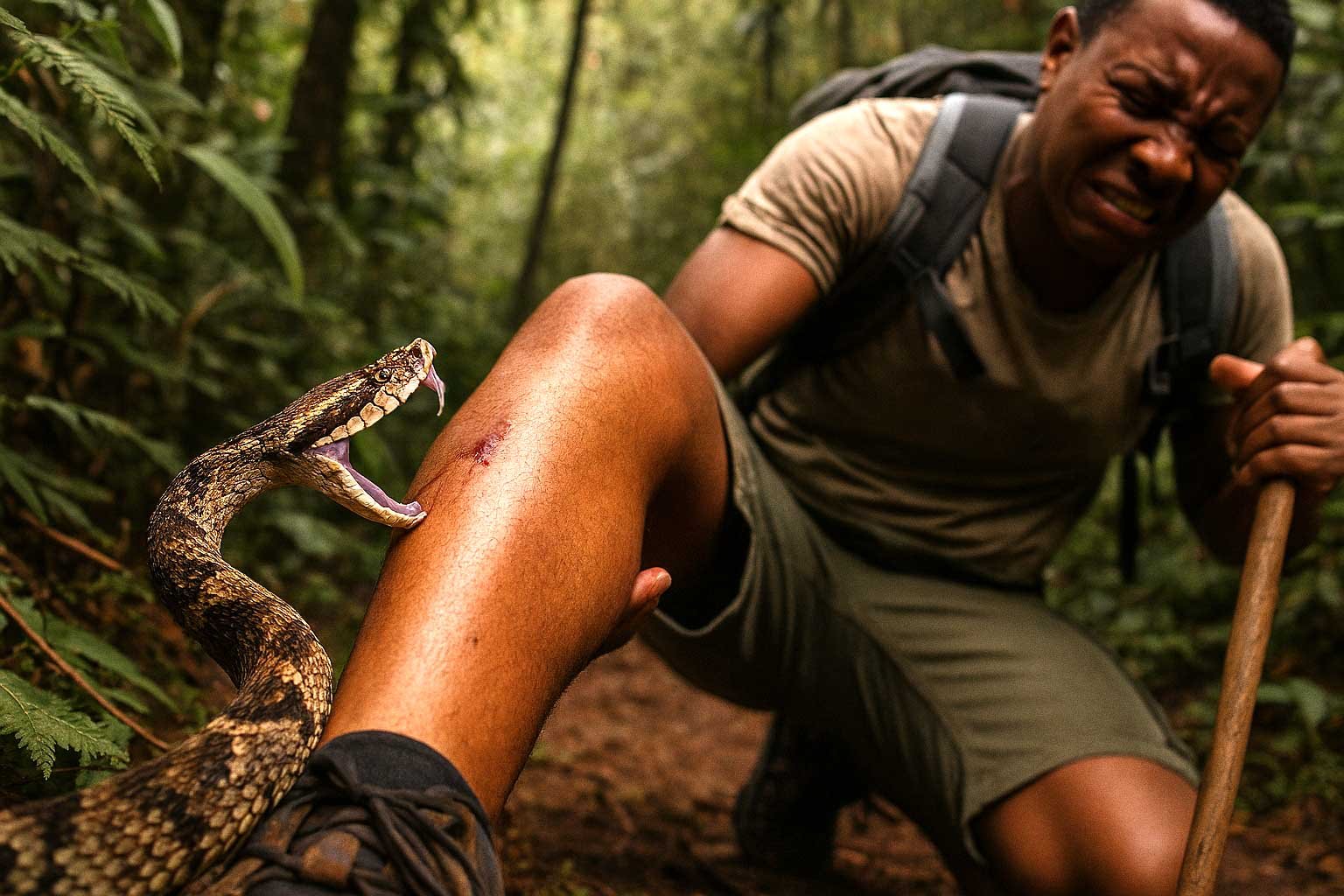
🤕🩹 FIRST AID
If someone is bitten by a snake, including Terciopelo, immediate and informed action is critical. Here’s a clear, step-by-step guide based on recommendations from the Instituto Clodomiro Picado, Costa Rica’s leading authority on venomous snakes:
✅ What To Do Following a Snake Bite:
- Stay calm: Panic increases heart rate and spreads venom faster.
- Call emergency services (dial 9-1-1) immediately. If you are alone, you will be given instructions.
- Lay the person down and keep them still.
- Clean the bite area gently with disinfectant soap and water.
- Remove tight clothing, jewelry, or shoes near the bite to allow for swelling.
- Immobilize the affected limb using a splint or sling.
- Keep the limb below heart level to slow venom spread.
- Keep the person hydrated, if they’re conscious and not vomiting.
- Transport to the nearest hospital as quickly as possible for antivenom treatment.
🚫 What Not To Do Following a Snake Bite:
- Do NOT cut the site of the bite; there is a higher risk of infection or bleeding.
- Do NOT make any tourniquets. Tourniquets stop blood flow, causing damage to the muscle tissue.
- Do NOT place cold compresses, they could worsen the local lesions caused by the venom. Especially important for bites by species from the pitviper family.
- Do NOT administer any chemical substance or plant/animal extracts by any route to the patient. So far their efficacy has not been scientifically proven. The time lost trying to use these types of treatments is counterproductive for the affected person.
- Do NOT administer alcoholic beverages.
- Do NOT suck out venom with your mouth. This could favor infections in the site of the bite.
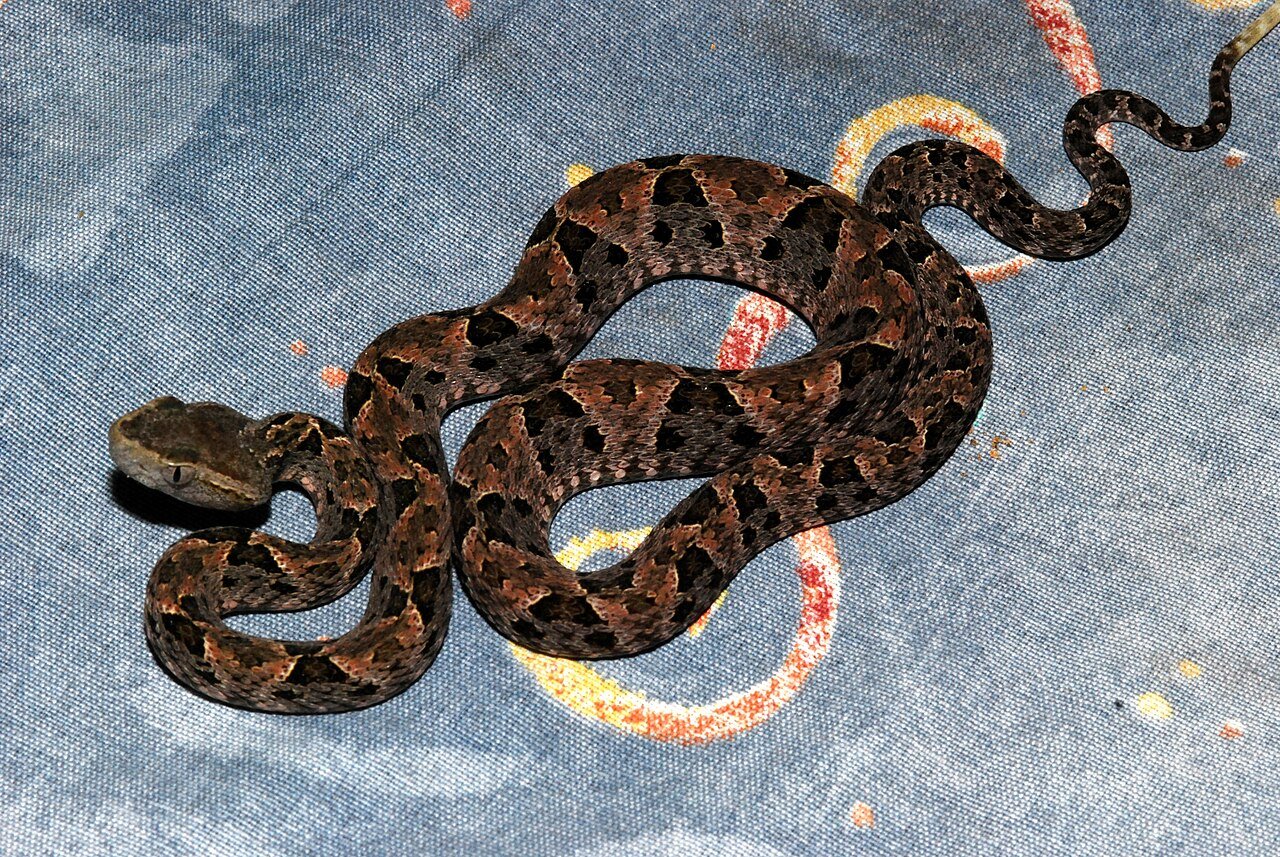
🐍💀 LEAVE THE SANKES ALONE!
Because of their fearsome reputation, Terciopelos are frequently targeted for extermination. The snakes that venture into human habitats often meet the sharp end of a machete. Many are intentionally ran down with vehicles – as we have all seen. Little mercy is shown to these critters and fear predominates.
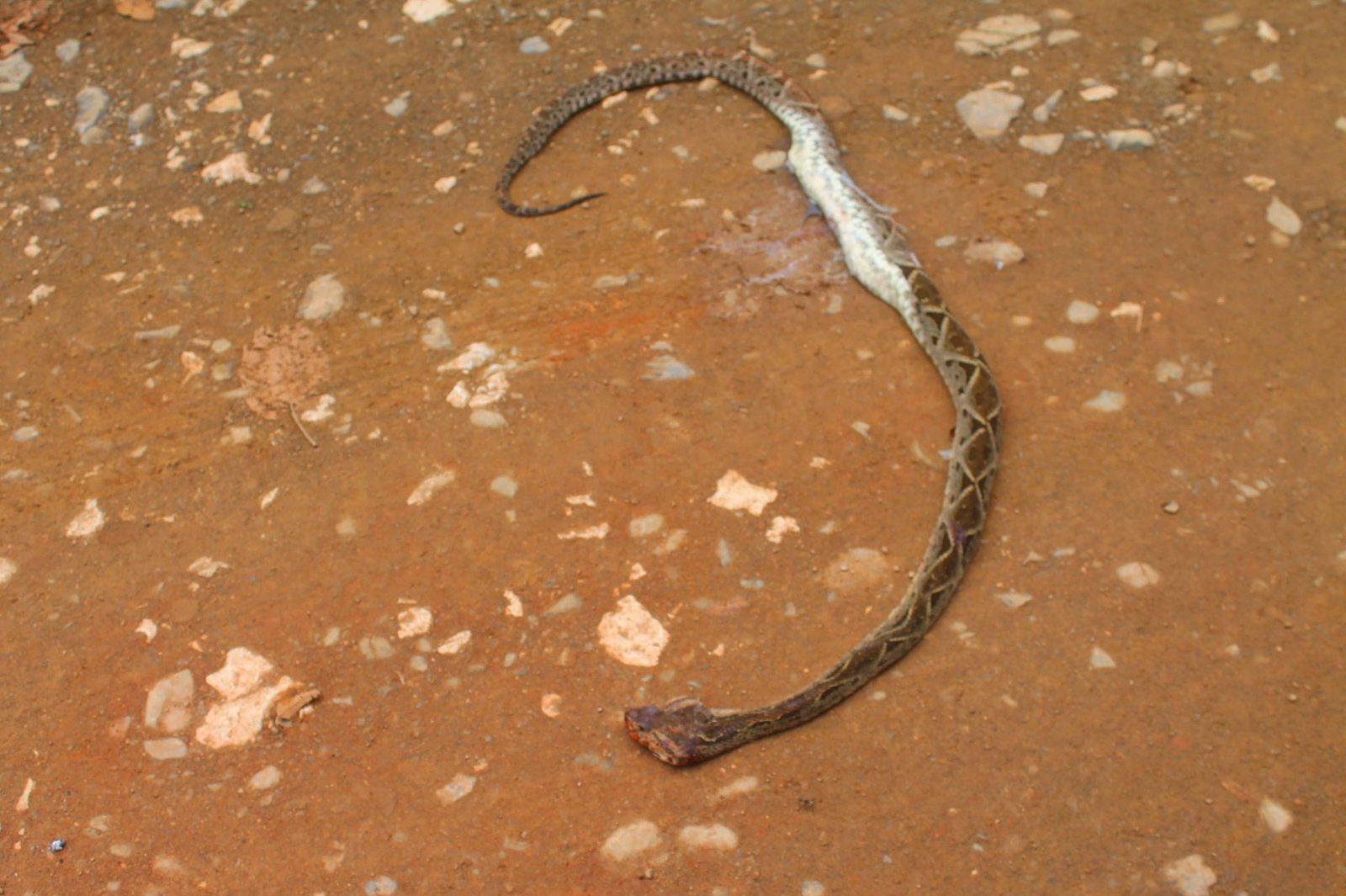
🐍🥇 THE SNAKE WAS HERE FIRST!
And yet these snakes were here first – in fact, calling Costa Rica home for at least 3 million years. 3 million years ago, our ancestor Australopithecus afarensis ruled the African plains. Remember the famous pre-human fossil called Lucy? That was 3 million years ago. And yet, at that very time, Pit Vipers were already here.
Humans only arrived in what is now Costa Rica about 10-12,000 years ago. And you can be sure that the first people of our area were keenly aware of the Terciopelo, just as we are today.
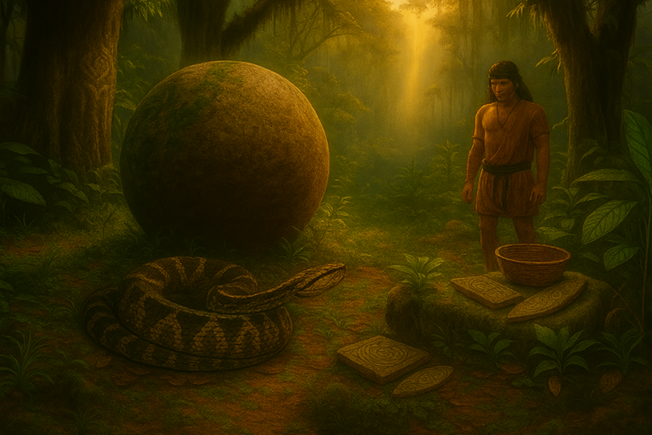
🐀🐭💉 AN IMPORTANT PART OF OUR ENVIRONMENT
Terciopelos help us in many ways:
- 🐭Rodent control – keeping agricultural pests and disease carriers in check.
- 🌱 Support for farmers – reducing crop damage without chemical pesticides.
- 🦅 Part of the food web – serving as prey for raptors and wildcats.
As a top predator in lowland forests and agricultural areas, the Fer-de-Lance helps regulate rodent populations that would otherwise damage crops and spread disease. By keeping these small mammals in check, the snake indirectly supports food security and reduces the need for chemical pest control. Its presence also contributes to the balance of the food web, providing prey for larger predators such as raptors and mammals.
Nature does not make mistakes and it seeks balance. So the Terciopelo is here because it belongs here. It has a vital role to play in our food web.
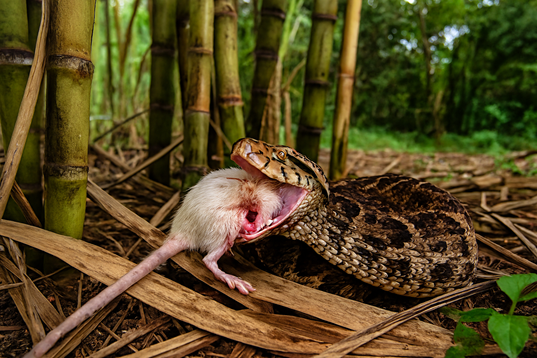
🧪🔬 BIOMEDICAL APPLICATIONS
1. Antitumor Potential
- Certain venom components can trigger apoptosis (programmed cell death) in cancer cells.
- Researchers are exploring how these toxins selectively target malignant cells without harming healthy tissue.
2. Blood Clotting Modulation
- Terciopelo venom contains enzymes that affect coagulation, making it useful for studying thrombosis and developing anticoagulants.
- Some proteins mimic or inhibit clotting factors, offering insights into stroke and heart disease treatment.
3. Pain Management
- Peptides in the venom show promise as novel analgesics, potentially more effective than opioids and with fewer side effects.
4. Nanomedicine Integration
- Scientists are encapsulating venom compounds in nanoparticles to reduce toxicity and enhance delivery to specific tissues.
- This approach boosts the venom’s therapeutic potential while minimizing risks.
5. Immunomodulation
- Components of the venom may help regulate immune responses, opening doors to treatments for autoimmune diseases or inflammatory conditions.

🐍✍🏼 A BIT ABOUT THE SNAKE
Finally, let’s not forget to talk about the animal itself – as there is more to this snake then its venom & reputation! The Fer-de-Lance is a master of camouflage and patience, thriving in the humid lowland forests of Central America. Mostly nocturnal, it spends daylight hours hidden beneath leaf litter or nestled among roots, emerging at dusk to hunt.
A Big Viper!
With a mass of up to 6 kilograms (13 lb), and a maximal length of 2.5 metres (8.2 ft), the Terciopelo is among the largest vipers. Specimens may weigh up to 6 kilograms (13 lb) and are often 1.2 to 1.8 meters (3.9 to 5.9 ft) in length. Very big females can reach lengths up to 2.5 metres (8.2 ft), although this is uncommon.
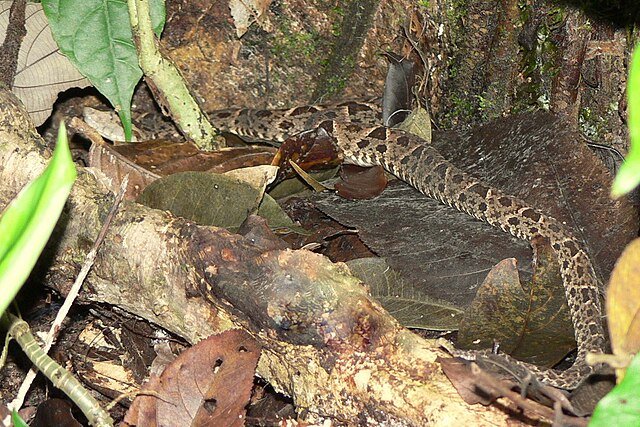
These are among the most sexually dimorphic of all snakes. The two sexes are born the same size, but by age 7 to 12 months, females begin to grow at a much faster rate than males. Females have thick, heavy bodies and grow significantly larger than males. They also have heads two or three times the size of males relative to their size and proportionally bigger fangs (typically 2.5 cm), as well.
The snake is generally light to dark brown in color, often with yellowish, zig-zag patterning on either side of its body.

Not a Fancy Eater
Its diet is impressively varied—ranging from frogs and rodents to birds and even other snakes—thanks to heat-sensitive pits that allow it to detect warm-blooded prey in near-total darkness. Juveniles often use a clever trick called caudal luring, wiggling their brightly colored tails to mimic worms and lure curious prey within striking distance.

Mating occurs during the rainy season, when males track females by following pheromone trails. After a gestation period of several months, females give birth to live young—sometimes dozens at a time—each already equipped with venom and instinct.
The snake ranges throughout Central America, from southern Mexico through to Peru, Ecuador, Colombia & Venezuela.

Habitat
This species likes moist environments, and occurs at low or middle elevations (up to 600 metres or 2,000 ft), excluding those with strong seasonal dry periods. They are, however, sometimes found at much higher elevations. This is true in the premontane forest in Costa Rica (up to 1,600 meters or 5,300 feet), the cloud forest of Guatemala and Mexico, or the lower montane wet forest in the Caribbean Region of Colombia and Ecuador. It chiefly inhabits tropical rainforest and evergreen forest, but it also occurs in drier areas of tropical deciduous forest, thorn forest and pine savannah near lakes, rivers and streams.
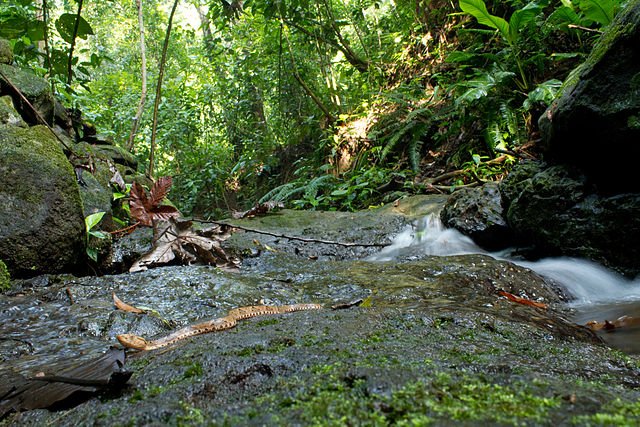
As seen in the photo above, these snakes are at home in our wet jungles. Let’s give them the awe & respect they deserve!
Coming across a coiled Fer-de-Lance is an unforgettable experience. Very few animals trigger our reptilian brain into a fight/flight/freeze response – and this snake is one of them! The Terciopelos are a vital part of our tropical landscape, and an ever present reminder that we are living in the frontiers of tropical jungles – real jungles. At RE/MAX WE SELL PARADISE we list hundreds of tropical properties – homes, land, farms, estates & businesses – all within a stone’s throw of the amazing rainforests, mountains, rivers and beaches that make Costa Ballena a world-famous destination. See our property listings here.



